Saving butterflies, moths and our environment
Celebrating our 40th Anniversary!
1982 - 2022
White Admiral larvae in Pamber Forest. Last year's studies into the White Admiral resulted in the identification of 3 types of hibernacula, which I phrased as "Cut and seal" (which is the "classic" and commonest type), "Seal and let wither" (which is very uncommon; I've only ever come across this twice) and "Fold" (details here). Of the 19 larvae I've been monitoring, only 11 remain (but the others may have moved; I'll have a more in-depth look when I have time) and all of these have now created hibernacula, which is slightly ahead of last year. I've spent at least twice the number of hours searching this year, with about half the tally of last year. So it doesn't look like this has been a good year for White Admiral, in line with most other species. Anyway ... I have to report a 4th type of hibernaculum, potentially, which seemed to be quite prevalent today, which I'll name "Half a Job" in that it is the start of the "Cut and Seal" type, but only half of the leaf is cut, and this half is then folded over. Now it could well be that the larvae will finish the job and I'll report back accordingly! However, the example on the superb pyrgus.de website shows that the leaf is fully cut and only then is the hibernaculum constructed. Watch this space! Of course, if "half a job" is a valid type of hibernaculum, then I am not assuming that all of the occupants will be male, should anyone ask :) [Posted by Peter Eeles]
 |  | 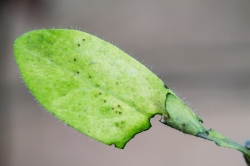 |
| Cut and Seal Photo © Peter Eeles | Fold Photo © Peter Eeles | Half a Job Photo © Peter Eeles |
Portsdown Hill. Visited Portsdown Hill today in fine weather, but despite that numbers of butterflies were low, apart from Whites. First walking the path in front of Fort Widley, I recorded Large White 5, Small White 15, Holly Blue 1, Meadow Brown 10, Speckled Wood 2.
Next a walk around Fort Widley saw less numbers; Brimstone 1F, Large White 6, Small White 8, Speckled Wood 3. [Posted by Roy Symonds]
Farlington Marshes. Eight Clouded Yellows and good numbers of Small Heaths around Farlington Marshes.
Then on arriving back home late afternoon found a female helice Clouded Yellow necturing on buddleia in our back garden.We then noticed Charlie our cat had found a Privet Hawk Moth caterpillar,which we quickly rescued.(Barry and Margaret Collins) [Posted by Barry Collins]
Clouded Days. On a perfect butterflying day spent at Old Winchester Hill on the main southern slope where the grasses are the right height for the Silver-Spotted Skipper they were flying about but they are certainly looking far more ragged now after a few days from seeing them the last time. The good news is that the Adonis Blue has emerged on this slope as well and they were fighting off Small Heath's and tatty old Chalkhill Blues. The best count came with the Clouded Yellow today as a count of (11) with an added bonus of seeing a mating pair which I've never seen before. The counts were as follows:Meadow Brown (Thousands) Small White (50+) Chalkhill Blue (20) Small Heath (25) Common Blue (50) Adonis Blue (21) Large White (3) Brown Argus (3) Brimstone (1) Silver-Spotted Skipper (15) Speckled Wood (1) Clouded Yellow (11) Painted Lady (2) Green-Veined White (1) Gatekeeper (2) Silver-'Y' Moths [Posted by Ashley Whitlock]
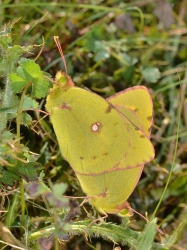 | 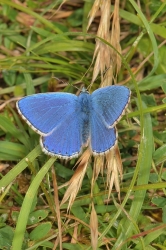 |  |
| Mating Clouded Yellows Photo © Ashley Whitlock | Adonis Blue Photo © Ashley Whitlock | Silver-Spotted Skipper Photo © Ashley Whitlock |
Noar Hill. Today I paid my last visit to Noar Hill to search for the Brown Hairstreak. Reportedly a poor season for the species here, I was again disappointed in not seeing one. I arrived shortly after 09.30am and stayed for 3.5 hours walking all of the main tracks. A total of 12 species were seen including a surviving Gatekeeper and two Silver Washed Fritillarys which were badly worn. Several fresh Small Heaths and Speckled Woods were seen.
Totals: Brimstone 1F, Large White 3, Small White 13, Common Blue 12M, Small Copper 1, Meadow Brown 15, Speckled Wood 12, Gatekeeper 1, Small Heath 11, Red Admiral 5, Silver Washed Fritillary 2, Small Tortoiseshell 4. [Posted by Roy Symonds]
Summer's lease ended. A visit to a largely desiccated Briddlesford Copse near Wootton, IoW, found just five butterflies: 2 tired Green-veined White, 2 immaculate 3rd brood Speckled Wood, and a solitary male Silver-washed Fritillary. Adjourning to the Buddle Inn, Niton, for lunch, a feral buddleja in the car park sported 1 Painted Lady, 1 perfect Small Tortoiseshell, and a barely recognisable Red Admiral. [Posted by Andrew Brookes]
Clouded Yellows at Haslar. I popped in briefly to the carpark between Haslar Detention Centre and the Golf Club. This is a favourite spot for Clouded Yellows. Late this afternoon it initially did not look too promising, just a couple of whites in the distance. However, on closer examination one of these 'whites' was in fact a helice Clouded Yellow. It was very flighty but I did manage one very poor shot before it disappeared. One Small Copper, a couple of Common Blues and a Meadow Brown kept me entertained before another female Clouded Yellow appeared. This normal coloured female was looking much more tired. [Posted by Paul Harfield]
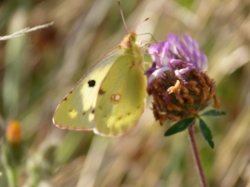 | 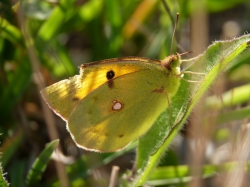 | 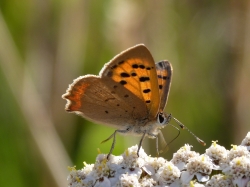 |
| Photo © Paul Harfield | Photo © Paul Harfield | Photo © Paul Harfield |
high cross. garden butterflies, comma 1, red admiral 2, small tortoiseshell 15, large white 2, small white 2, green veined white 1 [Posted by pat gardner]
Broughton Down. Although numbers of the Silver Spotted Skipper were low here this year,I took a chance to find them. Not a single one could I find having seen several at the same time last year. I did see at least 20 Common Blue with a good proportion of females, similar amounts of Small Heath,2 Adonis, 6 Brown Argus,50 plus Meadow Brown,1 Small Tortoiseshell, 6 Small White. [Posted by Ian Smith]
Painted Lady. A late report but in some wonderful evening light there were two Painted Ladies visiting buddleia in my garden.
Also my first Small Copper of the year locally, it has been very disappointing reflecting the constant cutting of small meadows throughout the year. Also Speckled Wood, Meadow Brown and Green-veined White
http://fourmarksbirding.blogspot.co.uk/ [Posted by Chris Rose]
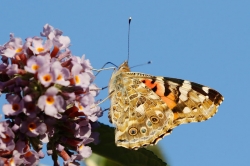 |  | 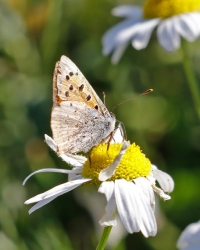 |
| Painted Lady Photo © Chris Rose | Painted Lady Photo © Chris Rose | Small Copper Photo © Chris Rose |
Old Winchester Hill. Today in hot and sunny weather, temperature 23 degrees, I visited Old Winchester Hill in order to search for Adonis Blue. I first walked down to the bottom of the car park slope where I located a total of 7; not flying on the slope itself but along the bottom paths. My walk took me through the woods then up the slope to the main track and around the hill fort. During this circular walk I saw a great total of 7 Clouded Yellows, all in flight. Chalkhill Blues have virtually finished here with barely half a dozen observed. Despite searching I could not find any Silver Spotted Skippers, however I did find a single Small Skipper. A total of 13 different species were seen, not bad for late Summer.
Totals: Clouded Yellow 7, Large White 5, Small White 5, Adonis Blue 7M, Chalkhill Blue 5M, Common Blue 15M 2F, Meadow Brown 88, Gatekeeper 2, Speckled Wood 2, Small Heath 10, Red Admiral 1, Small Tortoiseshell 2, Small Skipper 1. [Posted by Roy Symonds]
Late summer butterflies at St Catherines Hill. A pleasant amble round the sun-drenched south facing slopes of St Catherine's Hill revealed a spectacular showing of Devil's Bit Scabious, with clumps of Hemp Agrimony, Fleabane and other flowering plants attended by 100s of late summer butterflies. Predominant were Meadow Brown, followed by Common and Chalkhill Blue, Small Heath and Brown Argus with smaller numbers of Small White, Speckled Wood, Small Tortoiseshell and Red Admiral. Two Clouded Yellow and two resplendent male Adonis Blue provided an exotic touch. No Silver-spotted Skipper to be found, although conditions looked suitable. [Posted by Rupert Broadway]
Noar Hill NNR. On a sublime day for Ice Creams, the butterflies had all gone in for a Siesta by mid-morning at Noar Hill, it was that hot. This was my third visit for the Brown Hairstreak, in as many weeks and wandering around seeing lots of species but not the illusive target. However I met Tony James on his weekly transect and he told me the shocking news that the Brown Hairstreak was in his words' probably having one of their worst years', he had only seen a male on transect and that was it! My heart sank, Id seen one a few weeks ago, and I thought the females were probably at their peak now. The egg count of well over 100 in the early January certainly doesn't reflect the amount of adults seen on the wing at this site. However just after mid-day I met a couple who had seen at least three buzzing around an Ash tree, and necturing on Hemp Agrimony, and as we spoke one of them alighted on some Hemp Agrimony, it had obviously had had a dust up with a bird as part of its back wings were missing, and it was really faded.Still it still counts and I was delighted to see one even if it was past its best. Other species seen were as follows: Speckled Wood (17) Holly Blue (5) Common Blue (40) Meadow Brown (50+) Purple Hairstreak (3) Small White (21) Green-Veined White (1) Small Tortoiseshell (7) Large White (3) Small Heath (8) Red Admiral (10) Comma (2) Silver-Washed Fritillary (3) Painted Lady (2) Brimstone (6) Gatekeeper (1) Clouded Yellow (1) Brown Hairstreak (1) Brown Argus (1) Silver-'Y' Moth (5) Vapourer Moth (5). [Posted by Ashley Whitlock]
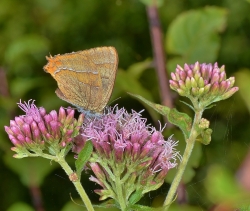 | 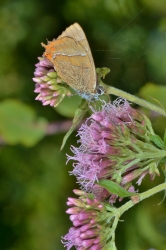 |  |
| Brown Hairstreak feeding on Hemp Agrimony Photo © Ashley Whitlock | Brown Hairstreak Photo © Ashley Whitlock | Female Common Blue fairly common throughout the area. Photo © Ashley Whitlock |
Gilkicker Fort. I had an hour to spare around 4pm, so as the weather was so good I thought I'd take the opportunity to see if I could see the Wall Brown that had been reported on the 22nd.
I'd visited that day with no luck and alas I had the same fate today.
I did however, manage a single Small Copper as it began to cloud over and 2 Common Blue.
My visit on the 22nd consisted of 2 mating Holly Blue, one Common Blue and a couple of Meadow Brown. [Posted by Ian Smith]
 |  |  |
| Common Blue Photo © Ian Smith | Small Copper Photo © Ian Smith | Small Copper Photo © Ian Smith |
Chalton Down Clouded Yellow. After photographing a Clouded Yellow at Noar Hill, on the way home I stopped at Chalton Down, just to see if one of the Clouded Yellows I saw there recently was still around to photograph. Shortly after crossing the gate I saw it and followed it for some time. It did stop very brieflty but not long enough to get a photo. [Posted by Roy Symonds]
Noar Hill. Today I visited Noar Hill in hot sunshine where the temperature reached 25 degrees. I searched as always for the Brown Hairstreak, but was unsuccessful again on this, my third visit, despite arriving at 09:30 hoping to catch one or two partaking breakfast. Good numbers and variety of species were seen, including Silver Washed Fritillary, a surviving Gatekeeper and a pair of Small Tortoiseshells, of which I have seen few this year. A highlight was seeing a Clouded Yellow which politely stopped for me to capture a photo.
Totals: Brimstone 20M 2F, Clouded Yellow 1, Large White 3, Small White 13, Common Blue 20M 3F, Meadow Brown 26, Speckled Wood 7, Gatekeeper 1, Small Heath 6, Peacock 2, Red Admiral 9, Small Tortoiseshell 2, Silver Washed Fritillary 6. [Posted by Roy Symonds]
Sparkling Blue, Silver Spots And Deep Yellow At Old Winchester Hill Part 2. Having just read Alan Thornbury's report about Old Winchester Hill I was going up there on the Monday as well but I thought it would be too windy so I went there today in blazing sunshine. With just a breeze to keep things just a little cooler with mainly Meadow Browns and still the Chalkhill Blue dotted all over the downs. On the far side of the southern slope the butterflies were out and I counted up to (17) species which isn't bad for the end of the season really. The Silver-Spotted Skipper was out and I counted (15) on these slopes, and around towards the car-park slope I counted (4), they are very active in this weather, but I feel they are still emerging here. There were also good counts of Adonis Blue with up to (12) being seen. Clouded Yellows were patrolling both slopes and counted (5). Overall numbers were as follows: Meadow Brown (100+) Brimstone (15) Small White (3) Gatekeeper (7) Chalkhill Blue (100+) Silver-Spotted Skipper (20) Common Blue (50+) Green Veined White (1) Clouded Yellow (5) Brown Argus (4) Small Skipper (1) Small Heath (12) Small Tortoiseshell (2) Red Admiral (2) Adonis Blue (12) Painted Lady (1) Large White (3) [Posted by Ashley Whitlock]
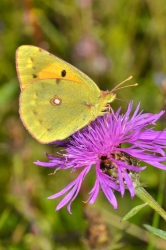 | 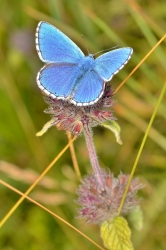 | 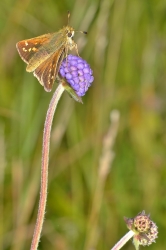 |
| Clouded Yellow Photo © Ashley Whitlock | Adonis Blue struggling on OWH Photo © Ashley Whitlock | Silver-Spotted Skipper on unopened Scabious Photo © Ashley Whitlock |
Portsdown Hill. After visiting Chalton Down where I saw two Clouded Yellows, I visited Portsdown Hill where the wind was stronger. Here I walked the downland slopes in front of Fort Widley where a dozen Chalkhill Blues were found. All other species were in low numbers perhaps due to the wind.
Totals: Large White 4, Small White 5, Chalkhill Blue 12, Common Blue 1F, Holly Blue 1, Meadow Brown 12, Gatekeeper 1, Speckled Wood 1, Red Admiral 1. [Posted by Roy Symonds]
Clouded Yellows at Chalton Down. Today I visited Chalton Down where there was a moderate breeze, but the temperature was 21 degrees. In common with other downland sites, I managed to see 2 Clouded Yellows. Just one at first flying strongly which was then joined by a second. Both then flew off fast in opposite directions. Numbers of butterflies are slowly decreasing now with only around two dozen Chalkhill Blues seen.
Totals: Brimstone 1M 1F, Clouded Yellow 2, Large White 5, Small White 4, Chalkhill Blue 27, Common Blue 1M, Meadow Brown 24, Gatekeeper 1, Small Heath 13, Comma 1. [Posted by Roy Symonds]
Sparkling Blue, Silver Spots And Deep Yellow At Old Winchester Hill. The title, if you hadn’t guessed, refers to Adonis Blue, Silver-spotted Skipper and Clouded Yellow, all seen at Old Winchester Hill this afternoon. I explored both the car park slope and the south field, next to the fort. At both sites there were also other members of the Blues - namely Chalkhill Blue (tens, mostly fading) and Common Blue (a few, in various states of wear).
At the bottom of the car park slope around 6 male Adonis Blues were seen, easily separated from the other blues. My Adonis attention was justifiably interrupted from time to time by a Clouded Yellow passing through this nectar rich habitat (4 seen), however no Silver-spotted Skippers were found in this area. My exploration of the south field was heading for disappointment, with no Adonis nor Skippers seen initially. Eventually, a small area where the turf is slightly shorter yielded just 3 Silver-spotted Skippers, all in reasonable, if not fresh condition.
It is clear that both Adonis Blue and Silver-spotted Skipper are facing serious challenges at this site, with the close cropped turf they need to thrive being largely absent. [Posted by Alan Thornbury]
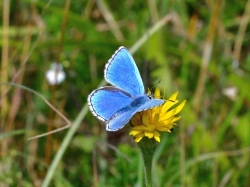 | 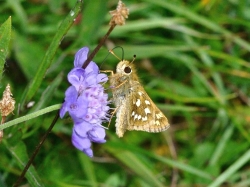 | 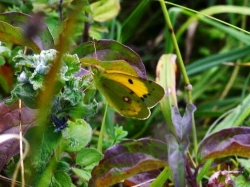 |
| Adonis Blue Photo © Alan Thornbury | Silver-spotted Skipper Photo © Alan Thornbury | Clouded Yellow Photo © Alan Thornbury |
Back Garden. With the wind keeping going out and about to a minimum, the garden tends to get overlooked. However in sheltered spots there is at least 6-7 species to be seen in good weather, and today I saw Painted Ladies, Comma's, Red Admiral's, Large White, Small Whites, Green-Veined Whites, Holly Blues, and out the front there has been a few Meadow Browns. I've also had a couple of Elephant Hawk Moth caterpillars one in the front garden and one out the back which was feeding off my fuchsia's. I can see why they are called Elephant Hawk Moths as the caterpillar looks very much like an Elephant's trunk with lovely eye spots to confuse and frighten off predators. [Posted by Ashley Whitlock]
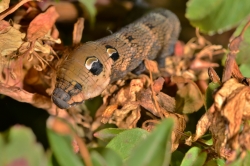 | 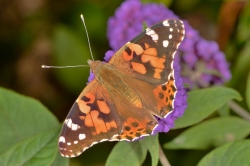 | 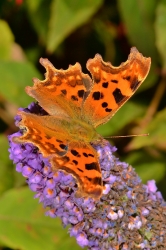 |
| Elephant Hawk Moth Caterpiller Photo © Ashley Whitlock | Painted Lady on Buddleia Photo © Ashley Whitlock | Comma on Buddleia Photo © Ashley Whitlock |
Wall Brown at Fort Gilkicker.. A male Wall Brown was basking and patrolling at Fort Gilkicker,Gosport. [Posted by David Tinling]
Jersey Tigers in my Gosport garden.. A Jersey Tiger was flying in afternoon sunshine in my garden at Haslar(north-west),GOSPORT,diplaying its bright orange-red underwings.After it had landed in a Pittosporulm tree,it climbed onto my finger,where I photographed it.In my garden moth-trap in August I have had about 30 visits from Jersey Tigers and 5 from Garden Tigers.Also an Evergestis limbata and a Tree-lichen Beauty. [Posted by David Tinling]
Arreton downs, Isle of Wight. A walk in very high winds with sun cloud and rain. Many Chalk Hill Blues seen battling the weather,3 Common Blues, 4 Small Heath, 20 Meadow Browns, 9 Gatekeepers,1 Holly Blue,2 Speckled Wood,1 Red Admiral. [Posted by mick sivell]
Two Forts. I visited two old haunts today both adjacent two of Lord Palmerstons follies.
The first is a very narrow strip of scrubland in front of Fort Purbrook. I used to patrol this area in my school holidays well over forty years ago when Wall Browns were two a penny here - sadly no more, but the area looks fantastic with masses of flowers including Scabious, Hemp Agrimony, Golden Rod and copious Thyme and various thistles. Good numbers of Common Blue were seen, with Meadow Brown and a single Small Blue. Pleasingly half a dozen Brown Argus were noted - these being a first for me at this site.
Moving on to the area below Fort Widley the area again looks fabulous - the Scabious being so prolific it seems to create a blue haze. The season is definitely nearing its end, sadly, and the most common species were Meadow Brown and Common Blue, but again pleasing numbers of Brown Argus. A male and female Clouded Yellow were zooming all over the site leaving me in no doubt about the power of their flight that propels them across the English Channel. [Posted by Mark Tutton]
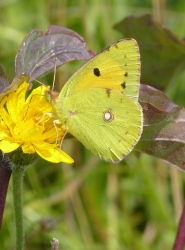 |
| Clouded Yellow Photo © Mark Tutton |
Chalton Down. After visiting Oxenbourne Down, I called in on Chalton Down where slowly the skies began to get more cloudy. Numbers of Chalkhill Blues appeared to be slowly decreasing, while Small Heaths are now increasing in numbers. I was also pleased to spot a fresh Small Copper.
Totals: Brimstone 1F, Large White 2, Small White 6, Chalkhill Blue 36M, Holly Blue 1, Small Copper 1, Meadow Brown 26, Gatekeeper 6, Small Heath 12. [Posted by Roy Symonds]
Oxenbourne Down. Today I returned to Oxenbourne Down to search for Silver Spotted Skippers. I saw a total of 8, as well as a Brown Argus which has proved to be elusive to me this year. Totals: Brimstone 1M, Large White 1, Small White 1, Brown Argus 1, Chalkhill Blue 75M 6F, Meadow Brown 42, Gatekeeper 9, Small Heath 7, Small Skipper 1, Silver Spotted Skipper 8. [Posted by Roy Symonds]
Sinah Common. Took a day off from butterflies to concentrate on dragon flies on Sinah Common this morning - but came across this striking blue in the scrub. Given the location and time of year I think it must be a female Common Blue - but am very happy to be corrected if necessary! The photo doesn't do the butterfly justice - despite being obviously a little worn the colours were very vivid in the field, a lovely mix of bright blue and orange. [Posted by Mark Wagstaff]
 |
| Common Blue - Sinah Common Photo © Mark Wagstaff |
Portsdown Hill Sites. Today I visited three different sites at each end of Portsdown Hill. Starting at Fort Widley, numbers were low due to a strong North wind. Totals: Large White 1, Small White 3, Common Blue 3M, Holly Blue 1, Meadow Brown 5, Speckled Wood 4.
Next crossing the road I walked the path along the ridge directly above Queen Alexandra Hospital. Here numbers were still low but with more variety. Totals: Brimstone 2F, Large White 5, Small White 4, Common Blue 2M, Holly Blue 1, Meadow Brown 5, Speckled Wood 3, Painted Lady 1.
Finally I called at Paulsgrove Chalk Pits where many Whites and Meadow Browns were flying. As I arrived at the gate leading into the area, a Clouded Yellow flew fast past me - the first I have seen this year. Totals: Large White 4, Small White 7, Clouded Yellow 1, Meadow Brown 21, Gatekeeper 2, Red Admiral 1. [Posted by Roy Symonds]
Noar Hill. Today I paid another visit to Noar Hill to try and find the Brown Hairstreak. Still plenty of different species were flying, 15 in fact, but no Brown Hairstreaks were spotted by myself or by a few other people I met with.
Totals: Brimstone 16M 6F, Large White 7, Small White 11, Common Blue 11M 1F, Holly Blue 1, Meadow Brown 32, Gatekeeper 3, Speckled Wood 6, Small Heath 6, Comma 2, Peacock 5, Red Admiral 9, Silver Washed Fritillary 5, Small Skipper 2. [Posted by Roy Symonds]
Beacon Hill NNR. I ventured up to this wonderful flower rich site in the vain hope there may have been a Silver-Spotted Skipper on the wing. If there was I certainly didn't see any, unfortunately. There were plenty of other butterflies of which were as follows: Common Blue (35) Brown Argus (17) Green-Veined White (2) Red Admiral (4) Meadow Brown (100+) Brimstone (23) Clouded Yellow (4) Small Heath (12) Dark-Green Fritillary (1) Gatekeeper (10) Chalkhill Blue (27) Small Skipper (1) Speckled Wood (4) Silver-Washed Fritillary (1) Peacock (1) Brimstone Moth (1) Many Silver 'Y' moths. [Posted by Ashley Whitlock]
 | 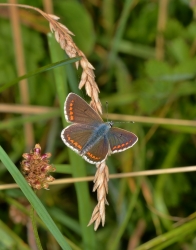 | 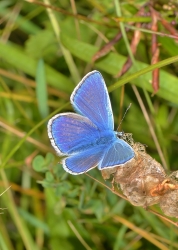 |
| Clouded Yellow probably came over on the spanish flume Photo © Ashley Whitlock | Brown Argus now the Gem of the Downs Photo © Ashley Whitlock | Common Blue now living up to its name. Photo © Ashley Whitlock |
Oxenbourne Down. Today, after being kindly given directions by Ashley Whitlock, I paid my first visit to Oxenbourne Down (SU7118). Here I spent 3 hours in temperatures of 22 degrees searching for Silver Spotted Skippers. I was lucky to find a total of 5 and managed a good photo, as there were very active in the sunshine. It was nice to see lots of Chalkhill Blues too, where my count underestimates the total numbers at the site.
Totals: Brimstone 1M, Large White 1, Small White 5, Green Veined White 1, Chalkhill Blue 99M 5F, Common Blue 2M, Meadow Brown 35, Gatekeeper 8, Small Heath 5, Small Skipper 1, Silver Spotted Skipper 5. [Posted by Roy Symonds]
Golden Brown Double Streak. Popped into Noar Hill for a couple of hours around lunchtime and the Brown Hairstreak seems to be having a good year. Two egg laying females and a male were encountered on the north path to the reserve so it was a great start - two each of males and females were tracked down inside the reserve along with four possibles - the Golden Brown Double Streak was the old name for the female Brown Hairstreak back in the 1700's when the male and female were thought to be different species. [Posted by Mark Tutton]
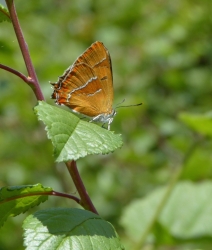 |  |
| Golden Brown Double Streak - Female Photo © Mark Tutton | Brown Double Streak - Male Photo © Mark Tutton |
Paulsgrove Chalk Pits. Today in the sunshine with a temperature of 23 degrees, I walked the main tracks around Paulsgrove Chalk Pits, where I was searching for any remaining Small Blues. Plenty of Whites were flying, but numbers of Chalkhill Blues and Common Blues were low. I did succeed in finding just a single male Small Blue which was resting. Once it took off it was so fast I was unable to locate it again.
Totals: Brimstone 2M 1F, Large White 9, Small White 18, Green Veined White 2, Common Blue 5M 4F, Chalkhill Blue 25, Small Blue 1, Meadow Brown 45, Gatekeeper 2, Peacock 1. [Posted by Roy Symonds]
Charlton Down/Idsworth Down/Oxenbourne Down Field Trip. Today was a game of two halfs, the Field trip in nice sunny weather in the morning, up onto Charlton Down, a supply of Chalkhill Blue, probably the least I've ever seen up there, and a splattering of other species like Brown Argus, Common Blue and Small Heath. Onto Idsworth Down which in the past has been a very good site for many species but today it was just Meadow Brown and a few Common Blues, just too overgrown really for any decent counts. I decided to go up to Oxenbourne Down which was a stones throw away in the afternoon, although now it was very cloudy and quite breezy at times, and several of us went up there in the afternoon. Here the Silver-Spotted Skipper was out and was easy to spot, as most of the Small Skipper and Essex Skipper have now finished. We saw up to (10) several females, and a mating pair of which ended up not being a mating pair as the female seemed reluctant to mate. The male tried everything, although flowers and a dinner date might have won her over, but she just kept shrugging him off. It was good to see the difference at close quarters how the sexes look, with the female being more chocolaty brown in colour on the hind wings. We all went away happy and I thank everybody who came today and made the afternoon a bit more interesting than the morning. [Posted by Ashley Whitlock]
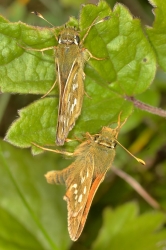 |  | 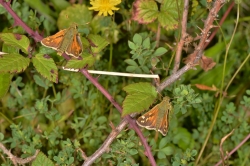 |
| Up close but just not quite! Photo © Ashley Whitlock | Some male Chalkhills still look in good condition Photo © Ashley Whitlock | He kept in close contact with her for 30 odd minutes Photo © Ashley Whitlock |
Clouded Yellow at Gosport Golf Course. A male Clouded Yellow was flying west along the edge of Gosport and Stokes Bay ..Golf Course(north-west) [Posted by David Tinling]
Old Winchester Hill. Today with sunny skies and a temperature of 22 degrees, I visited Old Winchester Hill, where I hoped to search for the Silver Spotted Skipper. I walked to the Hill Fort, covering all sides and the inner path, as well as walking to the gate at the extreme Western end. I returned back via the stepped path and back to the main path avoiding the wood and car park slope. A total of 12 species were seen with good numbers of Brimstones, Whites and Meadow Browns, while numbers of Chalkhill Blues were very low. No sign of any Silver Spotted Skippers in the areas I walked or Adonis Blue, but a single Painted Lady was seen.
Totals: Brimstone 24M 6F, Large White 20, Small White 22, Chalkhill Blue 24M 4F, Common Blue 24M 1F, Meadow Brown 112, Gatekeeper 4, Comma 2, Painted Lady 1, Peacock 8, Red Admiral 4, Small Skipper 1. [Posted by Roy Symonds]
Shipton Bellinger. A day to remember at Shipton Bellinger - for good and bad reasons! First the good - a lovely warm sunny morning rewarded by 8-9 Brown Hairstreaks in the period 1000-1200. The walk up from the village had 4-5 but in the tree tops. The boundary edge at least another 4 - this time nice and close. The not so good - possibly the worst behaviour I've ever witnessed by a photographer in the field - just appalling. If anyone who witnessed it is reading this they will know exactly what I mean - suffice to say it's probably best not to go into the details here. Better to complement the other enthusiasts there without whom I wouldn't have seen the hairstreaks close up - many thanks! It's one thing to spot them near the tree tops with my binoculars (days of practising looking for their white letter cousins has obviously helped!) but spotting one low down or even at eye height in blackthorn is a skill I haven't acquired yet so thanks again to those who not only helped find some today, but willingly stood aside in order for me to get a shot or two. [Posted by Mark Wagstaff]
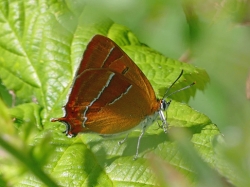 | 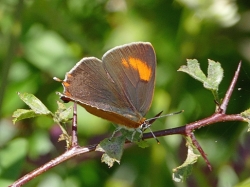 |
| Brown Hairstreak - Shipton Bellinger Photo © Mark Wagstaff | Brown Hairstreak - Shipton Bellinger Photo © Mark Wagstaff |
Noar Hill. Very warm conditions today but with a breeze which I think kept the majority of the Brown Hairstreaks in the trees seeking shelter. One was espied in the usual triangle area sat in a Ash tree about 12-15 feet above head height. She was in the tree for about ten-fifteen minutes or so and Pauline and I managed to see it escape into a Hemp Agrimony bush but could we find it...no we couldn't. However the butterfly count today was quite impressive for a change:Painted Lady (1) Meadow Brown (50) Gatekeeper (25+) Chalkhill Blue (female obviously flown in from the colonies at Ashford Hill NNR) Red Admiral (50+) this was probably a low count as they were everywhere on the Hemp Agrimony. Brimstone (25+) Peacock (10+) Comma (2) Silver-Washed Fritillary (11) Small Tortoiseshell (4) Large White (2) Common Blue (6) Ringlet (3) Green-Veined White (1) Speckled Wood (3) Small Heath (1) Small Skipper (2) plus Silver-Y'S and Common Carpet Moths. [Posted by Ashley Whitlock]
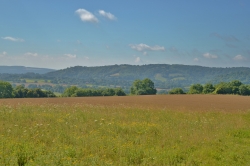 | 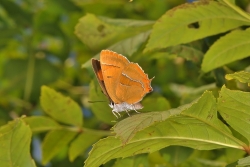 | 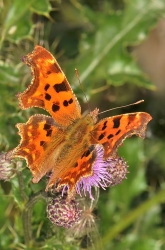 |
| The Hampshire Hangers from Noar Hill where the Chalkhill Blue came from Photo © Ashley Whitlock | Female Brown Hairstreak taking cover Photo © Ashley Whitlock | Comma on Thistle Photo © Ashley Whitlock |
Broughton Down. There was a good showing at Broughton Down today in warm yet blustery conditions. One Silver-spotted Skipper posed long enough for some pictures behind the obligatory grass stem|! A number of Common Blues were out and some Chalkhill Blues enjoyed the profusion of Marjoram. A couple of Brown Argus were in the more sheltered areas of the down. One early second-brood Adonis Blue was found at the far end of the reserve where a very faded but highly mobile Dark Green Fritillary remained active. Other common species included several Brimstone, Small Heath, Large White and Speckled Wood. [Posted by Dave Pearson]
 | 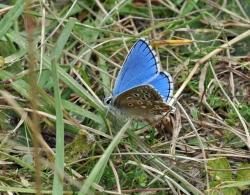 |
| Silver-spotted Skipper Photo © Dave Pearson | Adonis Blue Photo © Dave Pearson |
Unusual Meadow Brown, Butser Hill. This unusual Meadow Brown caught our attention on Butser Hill top on 10th August.
One rear wing is colourless. I also note a red mite, which are very common on Butser Hill butterflies. [Posted by R Boyd]
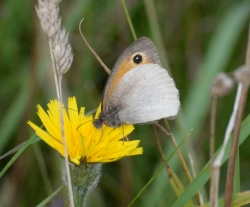 | 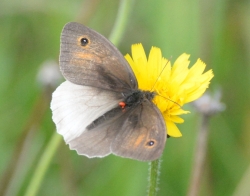 |
| Unusual Meadow Brown (1) Photo © R Boyd | Unusual Meadow Brown (2) Photo © R Boyd |
Common Blue Female Aberration at Noar Hill. Having edited my photos I took in Hampshire last week, back home in Cornwall I discovered a female Common Blue at Noar Hill on 9th August had a striking aberration. I have included the photo here. The area of orange on the upper fore wings which has elongated towards the body is close to a classified aberration - ab.rufina (Oberthür). [Posted by Richard Symonds]
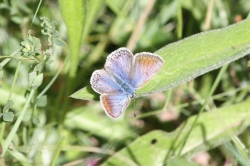 |
| Common Blue female ab.rufina Photo © Richard Symonds |
Noar Hill and Oxenbourne. A visit to Noar Hill 10-12 this morning was eventually rewarded after a lengthy search with a single pristine Brown Hairstreak on bramble near the main path as it opens up before sloping down to Charity Farm. It departed very rapidly, only allowing a couple of hurried snaps. Other numbers remain good on this site - 21 Red Admirals,12 SW Fritillaries, 6 Brimstones (all in one bowl nearest to the eastern end), 6 Commas,4 Peacocks, 1Painted Lady, 3 Common Blues and plenty of Gatekeepers and M. Browns. I then went back to Oxenbourne (mainly to search for some red framed sunglasses lost there last week). Although being distracted with my search, I was still able to count 3 Silver Spotted Skippers,1 Dark Green Fritillary, 50+ Chalkhills and 15+ Common Blues. Strangely there were no Red Admirals or Peacocks, unlike last week. If anyone comes across my sunglasses,please let me know! [Posted by Phil Hooper]
Noar Hill. Today my father, Roy Symonds and I visited Noar Hill (SU7431), encouraged by recent reports of sightings of the Brown Hairstreak. Despite searching almost all the paths and tracks around the site, including those where we had seen it before, we drew a blank. We did however see a total of 17 different species. Several areas which were covered with wild flowers including Knapweed and Scabious were surprisingly absent of butterflies - unusual for this time of the year, just reflecting on how overall numbers have been low this year. Many of the Nymphalids, especially the Peacocks and Red Admirals could be found nectaring on various large areas of Hemp Agrimony. A reasonable number of Silver Washed Fritillarys were seen with some males looking quite fresh.
Totals: Brimstone 10M 4F, Large White 4, Small White 6, Green Veined White 4, Common Blue 11M 7F, Holly Blue 2, Meadow Brown 33, Gatekeeper 19, Small Heath 4, Speckled Wood 2, Ringlet 1, Peacock 14, Red Admiral 20, Comma 2, Silver Washed Fritillary 14, Large Skipper 1, Small Skipper 10. [Posted by Richard Symonds]
Oxenbourne Down. On a perfect butterfly day I went to one of the best sites for the Silver-Spotted Skipper - Oxenbourne Down. Today I managed to see up to (9) mind you many haven't emerged yet, in about a week I suspect the count here will three or four times that...hopefully, it was good here last year on the field trip. Other species seen were as follows: Small Skipper (19) Chalkhill Blue (100+) Small Heath (9) Meadow Brown (100+) Gatekeeper (50+) Small White (7) Green Veined White (5) Large White (14) Common Blue (6) Essex Skipper (6) Brimstone (6) Red Admiral (4) Holly Blue (1) several 6-spotted Burnet Moths as well. Many parts of the down need attention with management as this species the Silver-Spotted Skipper is getting less and less habitable downland in which to breed and fly. I've also seen very few Dark-green Fritillaries here this year. [Posted by Ashley Whitlock]
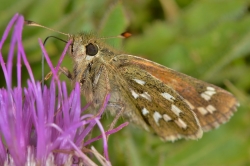 | 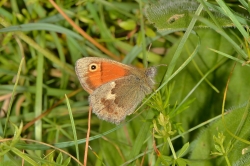 |  |
| Female Silver-Spotted Skipper Photo © Ashley Whitlock | Small Heath Photo © Ashley Whitlock | Male Silver-Spotted Skipper Photo © Ashley Whitlock |
Chalton Down Chalkhill Blue Aberration Photo. I am able to show here the aberration on the underside of the female Chalkhill Blue which I saw at Chalton Down on 8th August. From looking at several sources I believe it to be classified as ab.postcaeca (Bright & Leeds). [Posted by Richard Symonds]
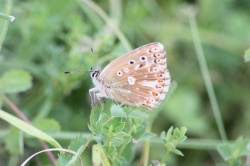 |
| Chalkhill Blue female ab.postcaeca Photo © Richard Symonds |
Chalton Down. Today my father, Roy Symonds and I visited Chalton Down (SU736156), where my target species was the Chalkhill Blue. Here I counted 52, but mostly at the Southern end where the turf was much shorter. A total of 15 different species were seen, with many Meadow Browns and Gatekeepers flying. Numbers of Common Blues and Small Heaths were low, but all in fresh condition. A nice surprise was seeing a single male Small Blue which put in a brief appearance. Someone had commented to my father that he had seen a few just recently at this site.
Totals: Brimstone 1M, Large White 8, Small White 14, Green Veined White 2, Chalkhill Blue 41M 11F, Common Blue 5M 6F, Holly Blue 4, Small Blue 1M, Meadow Brown 84, Gatekeeper 87, Small Heath 8, Silver Washed Fritillary 1M, Comma 1, Peacock 1, Small Skipper 1. [Posted by Richard Symonds]
Longstock census. Concluding the afternoon with a patrol of the buddlejas now in full flower at Longstock Park, a modest tally of vanessids was made. Red Admirals were again predominant (22), followed by Peacock (16). Painted Ladies (2) both favouring the cv. 'Summer House Blue', and, just to confirm their dreadful season, a solitary Small Tortoiseshell. No Commas, but from the number of final instar larvae found on young elm cultivars elsewhere, a good show is anticipated towards the end of this month. 4 Brimstones, 4 Large Whites and a Meadow Brown were also seen. [Posted by Andrew Brookes]
Shipton Belinger Hants BC Field Trip. The Hants Branch field trip to Shipton Belinger took place on a glorious sunny day. The 14 members enjoyed stunning close up views of our target species the Brown Hairstreak. A total of around 16 in total were recorded. The star being a freshly emerged female on our way back. As a group we recorded 20 species of butterflies in total with further highlights of Marbled White, Silver washed and Dark Green Fritillaries, the latter having seen better days. [Posted by Mike Gibbons]
 | 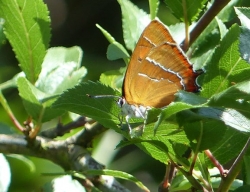 |
| Male Brown Hairstreak Photo © Mike Gibbons | Female Brown Hairstreak Photo © Mike Gibbons |
Pamber Forest, 6th August. Encouraged by a sighting of valezina on 4th August, I visited this site for the first time.
Alas, the amount of habitat and the size of the site quickly made me realise that the search was probably doomed to failure and so it proved.
Nevertheless, an enjoyable walk was had.
Silver-washed fritillaries were seen in many areas, albeit with a concentration out on the eastern side near Frog Lane. Most were males sporting varying degrees of wear/damage. This was in contrast to the New Forest last week, where the ratio of males to females was more even.
One tiny open area of flowers alongside one of the gravel tracks in the middle of the forest proved irresistible to brimstones, with 5-7 present at any one time; females outnumbering males. A single white admiral was also seen in this area.
Skippers were notable by their absence, with just a single small skipper and one or two large skippers being noted.
The cast list was completed by red admiral, peacock, ringlet, meadow brown and gatekeeper. [Posted by Paul Cox]
Oxenbourne Down. We visted Oxenbourne Down this afternoon from 1330-1500 and found at least 8+ Silver-spotted Skippers on the wing.Other butterflies of note included Dark Green Fritillary 4,Chalkhill Blue 40+ and one Marbled White.(Barry and Margaret Collins) [Posted by Barry Collins]
Brown Hairstreak at Noar Hill. Today at about midday and in warm sunshine, I visited Noar Hill. Once again I was greeted by a wonderful collection of wild flowers and was able to see 15 species of butterflies including lots of Red Admirals and 7 SW Fritillaries.
At the triangle I met Pauline Richards who had just seen and photographed a female Brown Hairstreak . I stayed for about an hour longer without seeing any myself.
On the way back ,via the wide path leading to the lower gate, I spotted a butterfly perched on the large flat flowerhead of an umbelliferous plant. Closer examination revealed that it was a Brown Hairstreak (male, I think). Sadly it was damaged an the lower parts of its back wings were missing.
If all goes well I shall include a photo! [Posted by Hazel Pratt]
 |
| Brown Hairstrak Photo © Hazel Pratt |
Broxhead Common. After visiting three sites in the Alice Holt complex, my father Roy Symonds and I visited Broxhead Common to see the last of the Silver Studded Blues. On arrival I coincidently met the Hampshire Branch Silver Studded Blue species champion conducting a transect count - what luck! He said numbers had been good, but they were almost finished now. After a little searching we saw a single female Silver Studded Blue busy feeding on heather.
Totals: Large White 2, Silver Studded Blue 1F, Gatekeeper 2, Meadow Brown 1, Small Skipper 1. [Posted by Richard Symonds]
Abbotts Wood Inclosure. My father, Roy Symonds and I visited Abbotts Wood Inclosure, where Purple Emperors had been seen in the past week. Despite searching, including areas where we saw two last month, nothing was seen. Like Straits Inclosure, numbers of butterflies here are now almost all in single figures, but 12 different species were seen. Although no Purple Emperors, I saw a butterfly land on low bracken and as I got closer to investigate saw that it was a worn male Purple Hairstreak which had still retained its tail. I managed a quick photo before it turned and took flight into a small Oak, where I was unable to spot where it had landed. This was a highlight for me as it was the closest I had viewed this species before.
Totals: Brimstone 1M, Large White 4, Small White 2, Green Veined White 6, Holly Blue 1, Purple Hairstreak 1, Meadow Brown 2, Gatekeeper 3, Speckled Wood 2, Silver Washed Fritillary 1M 2F, Comma 2, Peacock 2. [Posted by Richard Symonds]
Goose Green Inclosure. On our search for the remaining Purple Emperors, my father Roy Symonds and I called in Goose Green Inclosure, where we saw a male Purple Emperor last month. We were greeted with the sight of several Scottish and Southern Energy (SSE) vehicles. SSE were clearing and shredding the trees immediately adjacent to and surrounding the power lines running parallel to the road. This was to prevent earthing and line damage. A mess at the moment, but leaving a large open area for new foliage, eventually to recover and establish. For next year good news will be that the Sweet Chestnut master tree used by the Purple Emperors will once more be in full view from almost all sides, which was slowly being surrounded by other trees and bracken.
Only a few butterflies were seen, Brimstone 1M, Large White 4, Meadow Brown 1. [Posted by Richard Symonds]
Straits Inclosure, Alice Holt Forest. Today I visited Straits Inclosure, Alice Holt Forest while on a trip up from Cornwall in company with my father Roy Symonds. We were hopefully searching for any remaining Purple Emperors, but none was seen. On a day which started with cloudy and sunny spells, the sun came out with the temperature reaching 21.5 degrees. Overall numbers were low but a good variety of 15 different species were seen, including 2 worn White Admirals, 20 Silver Washed Fritillaries, with 5 Purple Hairstreaks seen around various Oaks. At one point what seemed like a dead leaf landed on the path in front of us, which turned out to be a very shredded and worn Ringlet. This was in complete contrast to the only other Ringlet seen which still looked quite fresh. We also observed a female Red Admiral oviposit on nettles and managed to locate and photograph the green ridged columnar ova.
Totals: Brimstone 1M 1F, Large White 2, Small White 9, Green Veined White 10, Purple Hairstreak 5, Meadow Brown 17, Gatekeeper 9, Speckled Wood 3, Ringlet 2, Silver Washed Fritillary 11M 5F, Red Admiral 3, Peacock 2, White Admiral 2, Large Skipper 1, Small Skipper 9. [Posted by Richard Symonds]
Productive Morning At Shipton Bellinger. After a quiet start at Shipton Bellinger this morning, under mainly cloudy skies, the late morning period was anything but quiet. A female Brown Hairstreak had settled on nettle leaves close to the track heading west from the village, followed soon after by 3 males seen nectaring on bramble in one section of the county boundary hedge. Male Brown Hairstreak activity was also observed in several of the Ash trees in these areas
The nectaring males were in various conditions from good to fair, however the female was in immaculate condition, possibly having just emerged this morning. She was initially spotted resting with closed wings, but as the sun began to poke through the cloud, she slowly opened her wings before flying off. [Posted by Alan Thornbury]
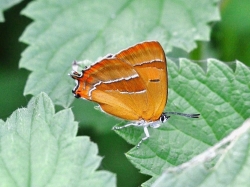 | 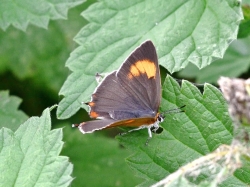 | 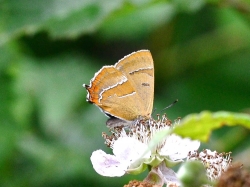 |
| Brown Hairstreak (Female) Photo © Alan Thornbury | Brown Hairstreak (Female) Photo © Alan Thornbury | Brown Hairstreak (Male) Photo © Alan Thornbury |
Pamber Forest specialties. I've spent a good amount of time at Pamber Forest over the last week, searching out White Admiral larvae as part of an ongoing study. I now have 25 recorded and it is still early days so I'm hopeful that many more will be found; I saw a couple of females still flying on 4th. Although I found another egg during my searching, most larvae have now moved into their second instar. Some shots below, together with a beautiful Silver-washed Fritillary f. valesina, which was a nice bonus! [Posted by Peter Eeles]
 | 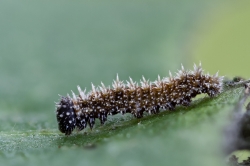 | 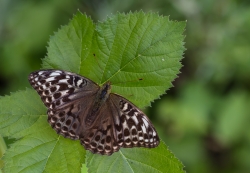 |
| White Admiral - 1st instar larva Photo © Peter Eeles | White Admiral - 2nd instar larva Photo © Peter Eeles | Silver-washed Fritillary f. valesina Photo © Peter Eeles |
Walls In Short Supply At Keyhaven. A walk this afternoon in the Keyhaven area, taking in the sea-wall, lagoon edges and the so called ‘Ancient Highway’ produced just two Wall butterflies (both males). Indeed there was generally a paucity of butterflies for a bright August afternoon, however it was extremely windy, especially along the sea-wall. This may have kept some ‘hunkered down’ to avoid being blown away!
The Wall butterflies were found in well separated, sheltered sections of track alongside the Keyhaven and Pennington lagoons. [Posted by Alan Thornbury]
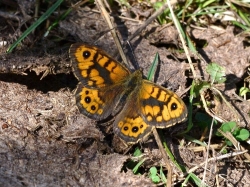 | 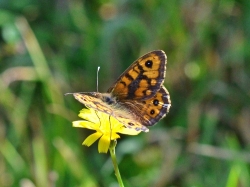 |
| Wall Photo © Alan Thornbury | Wall Photo © Alan Thornbury |
Chalkhill Blues at Yew Hill. 5 or 6 fresh male chalkhill blues plus a single female today at Yew Hill. Hanging on at the site by their fingertips. Other species noted - Essex skipper, large, small and green-veined white, brimstone, common blue (also thin on the ground), peacock, marbled white, meadow brown and gatekeeper. Plus red admiral, holly blue and speckled wood in the vicinity. [Posted by Rupert Broadway]